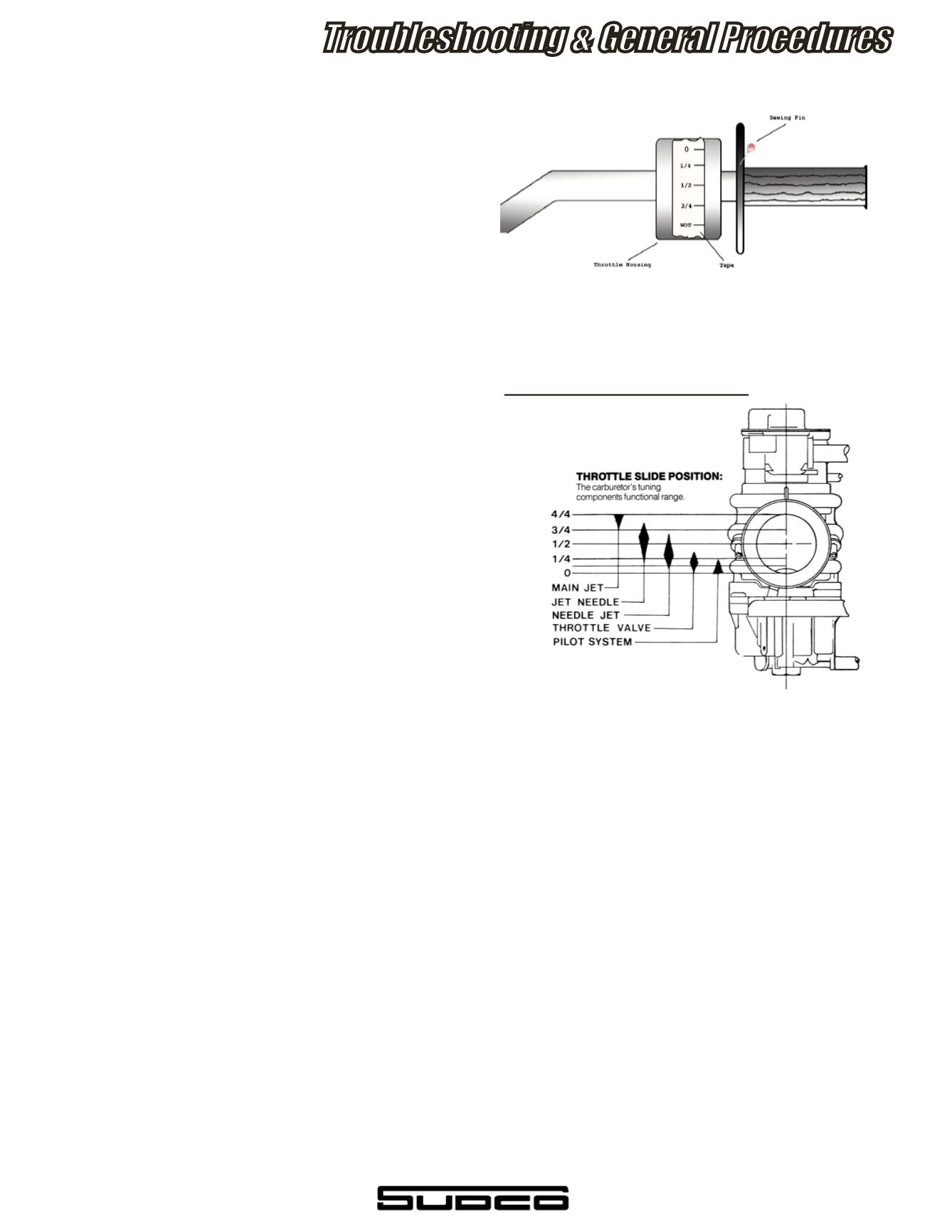

When turning motorcycle carburetors, there are several
procedures and preliminary checks that will make the tuning
and troubleshooting process go smoothly and quickly.
1. In order for carburetors to work properly, the engine must be
in good mechanical condition. All of the following parameters
should be checked in order to proceed with the carburetor tuning.
A.
Compression - all cylinders should be within 10%
of each other according to cranking compression
B.
Valve adjustment/Cam Timing - check valve clearance
according to the factory service manual, consult a qualiied
technician if there is any question about the cam timing.
C.
Ignition Quality - adjust point gap and ignition timing according
to the factory service manual. Double check the
gap and install new spark plug prior to any carburetor tuning.
D.
Air Filter Quality - Check to see that the air ilter is clean
and that all bafles and snorkels are in place, or have been
removed as necessary for increased airlow. In any case,
the air box / air ilter dimensions should be inalized.
E.
Exhaust System - Install all muflers and bafles.
Double check all silencer packing and bafle installation.
Finalize all exhaust system speciications before moving on
to the carburetors. Jetting can vary dramatically according to
mufler / bafle selection.
2. All fuel delivery circuits operate according to throttle
position. In order to determine which there is a problem. Do not use
R.P.M. to determine which circuit to tune. Sudco suggests the use of a
throttle index on the twist grip to track the exact throttle opening of the
carburetor.
Throttle Index
A.
Place a piece of masking tape access the throttle housing
adjacent to the twist grip so that it is visible from the riding position.
B.
Install a colored push pin or sewing pin into the throttle grip
lange adjacent to the masking tape. Adjust the throttle cable
free play to near zero.
C.
With the throttle closed, make a “0” mark on the masking tape
adjacent
to the pin head on the throttle lange.
D.
Open the throttle all the way and make a “W.O.T” mark on
the masking tape adjacent to the pin head.
E.
Using a tape measure, divide the distance between the
two marks on the tape into quarters and make marks for
each throttle opening on the tape. (0, 1/4, 1/2, 3/4, W.O.T.)
F.
Ride the motorcycle and make mental notes regarding
the carburetion according to the throttle index. If a problem
is truly carburetor related, the symptoms will come and go
according to the throttle position.
3. Work in progression from 0 throttle through full throttle.
Motorcycle carburetor fuel circuits are additive. This means the main
circuit delivery is an addition to the pilot circuit delivery. The pilot
system delivers fuel at all throttle settings, therefore, the timing of the
pilot circuit will have some inluence on the decision to be made
regarding the main circuit. If there is any question about the jetting of
the pilot circuit it should be addressed irst. After the pilot circuit has
been optimized it is then possible to accurately evaluate the main
circuit and it’s related components.
4. Altitude and Temperature
The purpose of the carburetor is to mix air and fuel in a speciic
ratio, by mass, in order to present a combustible mixture to the en-
gine.
Carburetors are generally lexible instruments when used to mix air
and fuel in the proper ratio and will compensate for small changes in
air density. It is when the altitude or temperature becomes extreme
that it will be necessary to re-jet according to atmospheric condition.
Altitude and temperature are important factors to consider
when tuning carburetors for peak performance, as they directly affect
air density. Notes should be taken regarding altitude and temperature
changes as they occur in order to determine which way to go with
carburetor adjustments.
Because air is a fas, its density is directly affected by altitude,
barometric pressure, temperature and humidity. These factors will
increase or decrease air density depending upon where you travel or
how weather patterns develop in your riding area.
Gasoline is a liquid and cannot be compressed. therefore,
its density is not affected by altitude, temperature, or humidity.
Throttle (Slide) Valve
The Carburetor’s tuning
components functional rate.
Troubleshooting & General Procedures
1.) Throttle Position
Component Functional Range - If re-jetting is required,
irst ind the throttle position where there appears to be a problem.
Then determine if the engine is running rich or lean by using the
Symptoms Chart on the next page.
527
















